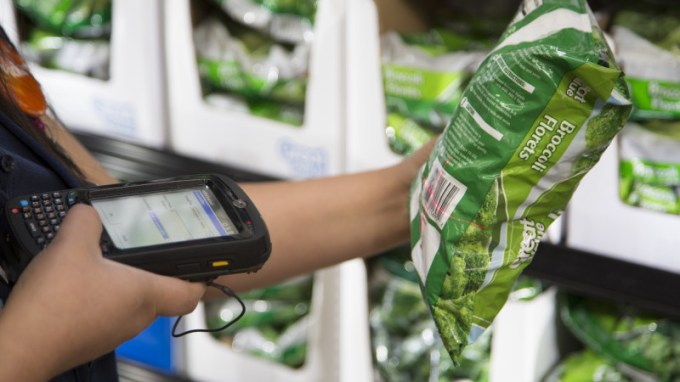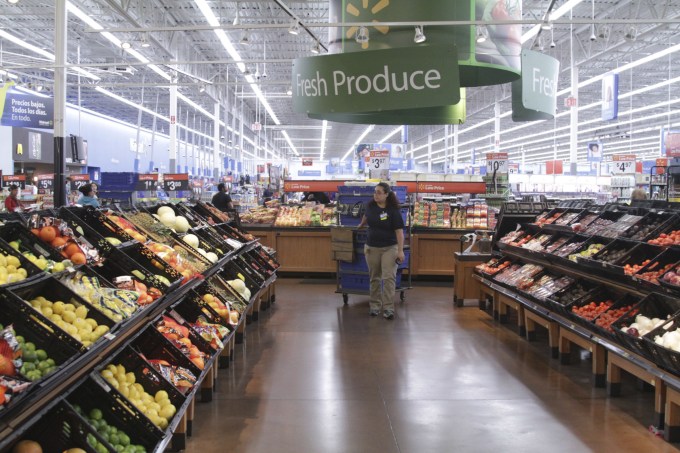Walmart and Sam’s Club will begin testing last-mile grocery delivery that uses services including Uber, Lyft and Deliv, to bring customers’ orders to their homes. The announcement is being made at Walmart’s annual shareholders week in Arkansas, and comes following the launch of a similar pilot program in Miami in March. There, Walmart-owned Sam’s Club is using the parcel delivery service Deliv to test delivery of general merchandise and groceries for its business members in the area.
With the new pilot program involving Uber and Lyft, Walmart customers will be able to shop using the company’s online grocery service at grocery.walmart.com, then request delivery at checkout for a small fee.
The company says it’s starting “small” with these tests and will let customers guide the process going forward.
The first tests will go live this week or the next in Denver and Phoenix. In one market, Uber will be trialed, while the other will use Lyft. (The company will test with UberX drivers, it says.)
Customers will place their online orders much as they would if requesting curbside pickup, and then specially trained Walmart Personal Shoppers fill those orders. These Walmart employees are trained to understand how to select the best meat and produce, and they quickly place frozen and fresh items in a designated, temperature-controlled holding area in the back of the store.
There are around 35,000 fresh groceries, dairy, meat, frozen foods, health and beauty products, baby items, and consumables available in Walmart’s online grocery store.
However, at checkout in these test markets, Walmart customers will be able to select the option to have their order delivered instead of opting for curbside pickup. (The Deliv pilot with Sam’s Club in Miami will continue as before, and follows a similar process)

When a Walmart shopper selects home delivery, they’ll choose a time frame, and pay an additional delivery fee of $7.00 to $10.00. This fee will help to offset the cost of using the third-party car services.
Walmart’s team will then request a driver from Uber or Lyft to come to the store using the normal mobile application. The company says Uber and Lyft are working with Walmart on the tests, and the drivers will be alerted in some fashion – perhaps via a text – that these are grocery orders, not passenger pickups, when summoned.
The driver picks up the already prepared order, and heads to the customer’s location. Walmart will call the customer to tell them the order is on its way.
This is not Walmart’s first experiment with grocery delivery. The retailer also has long run grocery delivery pilots of its own in both Denver and San Jose, California. However, it has not yet moved to expand upon that program. That hints that the company hasn’t figured out how to make the economics of home grocery delivery successful as an in-house program, or that customer demand hasn’t been as strong.
Tapping into Uber and other third-parties is another option Walmart now seems willing to consider as an alternative.

While grocery delivery has been a lengthy experiment for Walmart, more recently it has focused on curbside pickup as its big differentiator from the growing number of grocery delivery services, like those from Instacart, Peapod, Shipt, Amazon and Google.
Walmart has always said that pickup makes more sense for its customer base, who are more concerned with the cost of groceries rather than the convenience of doorside delivery, which tends to be pricey. Walmart doesn’t markup the cost of groceries, nor does it charge a pickup fee.
“Whatever you pay for apples or oranges or sliced deli meat, is the exact same price as you’ll pay with us online,” says Walmart’s director of Public Relations, Ravi Jariwala. “Part of pickup’s success has not only been saving time, but also saving money – you’re not paying more for the convenience…that’s the reason why grocery pickup has been so well-received by our customers,” he adds.
And with the upcharge of only around $10 for delivery, Walmart’s pilot grocery delivery services using Uber and Lyft will likely undercut rivals.
At the shareholders event, Walmart is also offering an update on its curbside pickup program, which was expanded in April to a number of new markets across the U.S., while also doubling its presence in some of its larger, established markets. This allowed Walmart to widen its footprint to 30 U.S. cities, it said at the time. It’s now live in 40 markets, and is now announcing expansions into 14 more in June.
By the end of July, Walmart will nearly triple the number of stores and markets that offer the service, compared to when it began expanding at the beginning of April 2016.
In other words, despite these Uber, Lyft and Deliv-powered delivery experiments, it’s clear that Walmart is still betting more heavily on curbside pickup for the time being.
